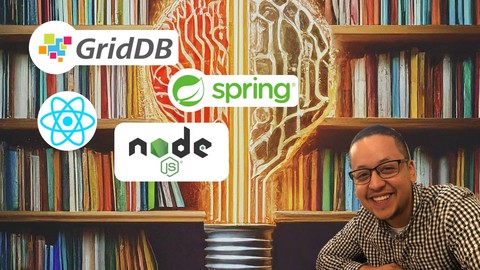
Building a Full Stack Java Application Part II
Building a Full Stack Java Application Part II, available at Free, has an average rating of 5, with 11 lectures, based on 1 reviews, and has 843 subscribers.
You will learn about Backend Development with Java's Spring Boot reactjs development interacting with a Spring Boot backend NoSQL Database interaction with Java partitioning/expiry functions with NoSQL Database This course is ideal for individuals who are Beginners looking to learn how to start a new project from scratch — from Zero to Built It is particularly useful for Beginners looking to learn how to start a new project from scratch — from Zero to Built.
Enroll now: Building a Full Stack Java Application Part II
Summary
Title: Building a Full Stack Java Application Part II
Price: Free
Average Rating: 5
Number of Lectures: 11
Number of Published Lectures: 11
Number of Curriculum Items: 11
Number of Published Curriculum Objects: 11
Original Price: Free
Quality Status: approved
Status: Live
What You Will Learn
- Backend Development with Java's Spring Boot
- reactjs development interacting with a Spring Boot backend
- NoSQL Database interaction with Java
- partitioning/expiry functions with NoSQL Database
Who Should Attend
- Beginners looking to learn how to start a new project from scratch — from Zero to Built
Target Audiences
- Beginners looking to learn how to start a new project from scratch — from Zero to Built
This course is part 2 in our series, teaching you how to build a full-stack Java application, from nothing to fully functioning! In this course, we will continue the work from part 1, making the frontend much more flexible, adding a new advanced view with a query builder allowing for aggregation functions. On the backend, we will be adding in partitioning and expiry rules so that our tables self-regulate themselves over time. We also made the backend a bit more flexible to better work with our frontend.
Source Code for this code can be found on our GitHub page which is found in the resources section of our Introduction lecture.
The passage that follows is from Course 1:
Follow along with the course to create a full stack log viewer app – from beginning to end. The application utilizes Java in a variety of ways to build out a logging app: native Java to interface with the NoSQL database (GridDB), JDBC to interface with the db using SQL, Spring Boot to build out a REST API, and finally JSON Parsing & HTTP requests with Java. Lastly, outside of Java, there is also some react.js for the frontend to query the Spring Boot backend and to create our data tables of our logs.
The basic premise of the app is split up into three parts: the log agent, the log processor, and the log viewer. The log agent is responsible for monitoring the host machine for logs of the user’s choosing. When it finds new data, it saves the raw logs into GridDB (the database of choice). Then, the log processor scans the db and finds new rows of raw logs, processes the data into proper fields (set by the user) and re-saves them into the database into a new table. And finally, the log viewer queries the database. The log viewer is comprised of a backend (Spring Boot) REST API, and a frontend (react.js) to view the parsed log data.
Course Curriculum
Chapter 1: Introduction
Lecture 1: Project Source Code
Lecture 2: Introduction
Lecture 3: Comparing New Course Content to Previous Course
Chapter 2: Chapter II – Partitioning and Expiry Release
Lecture 1: Introduction
Lecture 2: Partitioning and Expiry Hands-On – via GridDB Shell
Lecture 3: Partitioning Coding Section
Chapter 3: GridDB Aggregation Functions
Lecture 1: Introduction
Lecture 2: Group By Range Hands-On – Python via Jupyter Notebook
Lecture 3: Group By Range/Agg Functions using Java
Chapter 4: Chapter IV Frontend
Lecture 1: Introduction to Changes
Lecture 2: Frontend Coding / Walkthrough
Instructors
-
Israel Imru
Developer
Rating Distribution
- 1 stars: 0 votes
- 2 stars: 0 votes
- 3 stars: 0 votes
- 4 stars: 0 votes
- 5 stars: 1 votes
Frequently Asked Questions
How long do I have access to the course materials?
You can view and review the lecture materials indefinitely, like an on-demand channel.
Can I take my courses with me wherever I go?
Definitely! If you have an internet connection, courses on Udemy are available on any device at any time. If you don’t have an internet connection, some instructors also let their students download course lectures. That’s up to the instructor though, so make sure you get on their good side!
You may also like
- Top 10 Interior Design Courses to Learn in December 2024
- Top 10 Writing Courses Courses to Learn in December 2024
- Top 10 Storytelling Courses to Learn in December 2024
- Top 10 Creativity Workshops Courses to Learn in December 2024
- Top 10 Resilience Training Courses to Learn in December 2024
- Top 10 Emotional Intelligence Courses to Learn in December 2024
- Top 10 Time Management Courses to Learn in December 2024
- Top 10 Remote Work Strategies Courses to Learn in December 2024
- Top 10 Freelancing Courses to Learn in December 2024
- Top 10 E-commerce Strategies Courses to Learn in December 2024
- Top 10 Personal Branding Courses to Learn in December 2024
- Top 10 Stock Market Trading Courses to Learn in December 2024
- Top 10 Real Estate Investing Courses to Learn in December 2024
- Top 10 Financial Technology Courses to Learn in December 2024
- Top 10 Agile Methodologies Courses to Learn in December 2024
- Top 10 Project Management Courses to Learn in December 2024
- Top 10 Leadership Skills Courses to Learn in December 2024
- Top 10 Public Speaking Courses to Learn in December 2024
- Top 10 Affiliate Marketing Courses to Learn in December 2024
- Top 10 Email Marketing Courses to Learn in December 2024





















